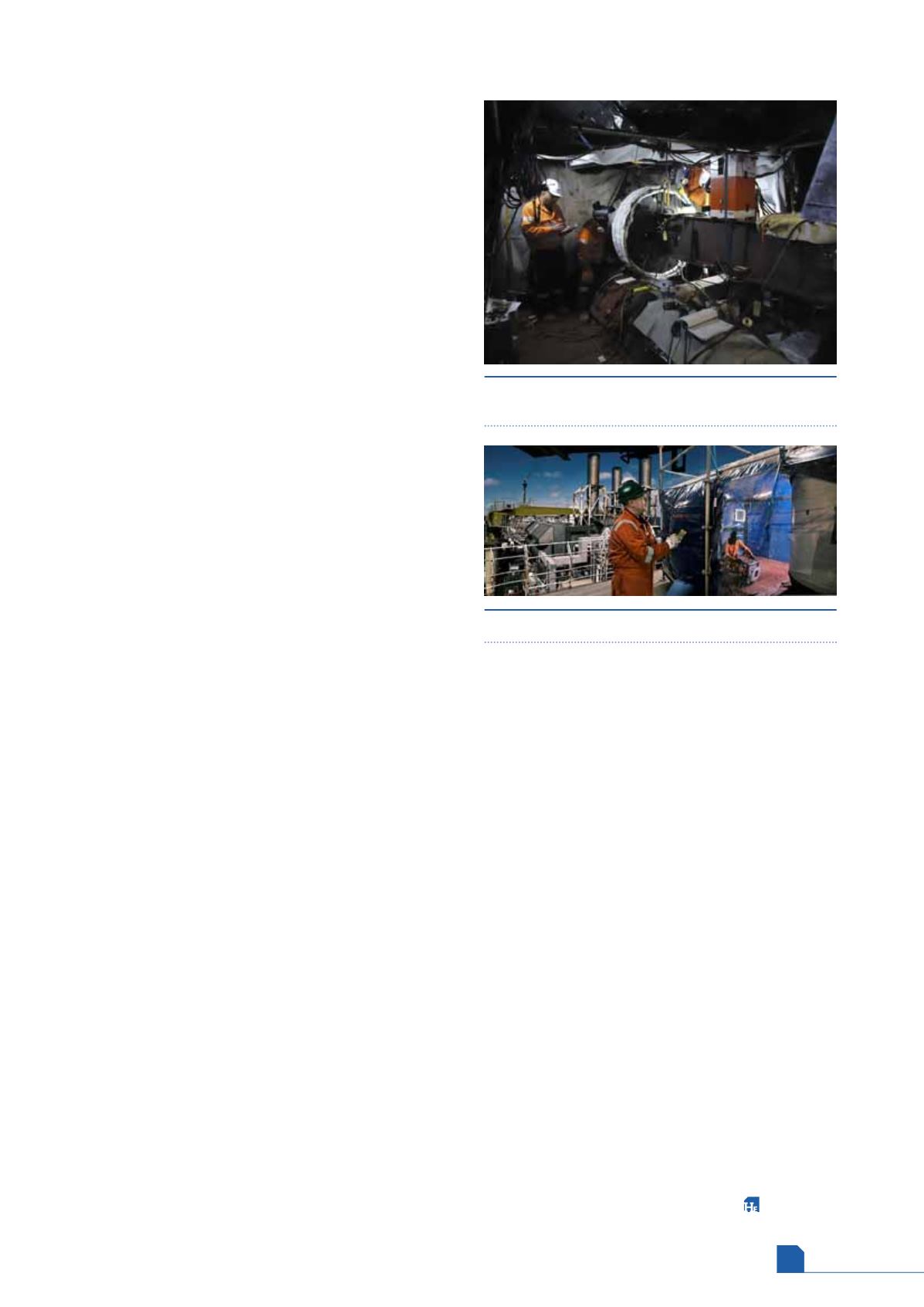
March
2017
HYDROCARBON
ENGINEERING
109
will trigger the shutdown of all tools, ensuring the safety of
those working within the habitat.
Karratha
Recently, hot work was required as part of a life extension
project at the Karratha gas plant, located north of Perth,
Australia. The upgrade of one of the LNG trains required
the field weld installation of a T-piece into an NPD800
hydrocarbon line, which was situated in a zoned area,
whilst the adjacent process was still operational. The weld
site was located at the top of the LNG train, almost 20 m
above grade. This led the site owner to seek an innovative
solution to address both the welfare issues arising from
extreme heat and the challenging nature of the job site due
to the presence of hazardous gases. Using the modular,
pressurised habitat, along with two SafeCool air
conditioning units to reduce the temperature and improve
staff welfare, multiple weld sites were planned. The works
were completed within the allocated timeframe and no
downtime was required. Through using an innovative
solution, the company was able to continue to operate,
improve productivity and ultimately achieve significant
cost savings in the long-term.
Wider industry challenges
The challenging climate experienced in recent years affects
all areas of the oil and gas sector. With access to more
limited resources, existing staff are often under pressure to
meet targets. This is where cross-industry innovation can
really make a difference. From streamlining processes to
simply looking at things in a different way, sharing
innovation between sectors is an effective form of low cost
improvement. Technology that has been ‘tried and tested’
in one area of the oil and gas industry is almost always
transferable, bringing with it cost savings and health and
safety improvements. This demonstrates a commitment to
the improvement of the industry at a time when it can be
difficult to maintain positive attitudes. There is an
opportunity to share knowledge to best equip the industry
to improve standards, particularly in addressing health and
safety concerns.
Cross-industry solutions
The marine industry worldwide is facing many challenges and
economic pressures, much the same as the oil and gas
industry. Complexities in processes and supply chain are
making it increasingly difficult for those in the marine sector
to meet targets. The UK government forecasts that the marine
sector will increase its value to the UK economy from
£17 billion to £25 billion a year by 2020, through greater
cooperation across the industry. One of the ways the
government foresees this increase in value being facilitated is
through advances in innovation and technology.
Cross-industry knowledge sharing, specifically focusing on the
application of new innovations, can help the marine sector
achieve the forecasted increase in value. Safehouse has
recently applied its pressurised habitat technology within the
marine sector, a relatively new application of the product,
which showcases the ability to help clients to achieve
significant cost savings. The company was tasked with tackling
urgent repairs aboard a vessel ‘en voyage’. During a routine
inspection on the vessel, cracks were identified in a
compartment housing non-intrinsically safe equipment. After
collaborating with the client, Safehouse developed a solution
to conduct the urgent maintenance en route between Belgium
and Finland. A pressurised habitat and experienced technician
were deployed to the site at short notice. The habitat was
then erected around an area where hot work was to take place
to allow for the repairs. Using this method of conducting hot
work within a hazardous area, the client saved
€
100 000 and
avoided four days’ unavailability of the vessel.
Conclusion
In recent years, fatalities and incidents in general have been
in significant decline across all areas of the UK oil and gas
industry. According to the 2016 Oil & Gas UK Health & Safety
Report published in August 2016, there have been no
reported fatalities for the offshore oil and gas industry in the
UK. The UKPIA annual review from 2016 also shows a
continued focus on safety as, for the 14
th
year running, the
downstream sector remains one of the safest manufacturing
industries in the UK, with proportionately fewer injuries than
all other areas of the oil and gas industry. The category of
dangerous occurrences – which captures oil and gas releases,
fires or explosions, dropped objects and weather damage
– was also down overall, with an almost 30% decline in
recorded incidents between 2013 and 2015. Innovation is one
of the key factors influencing this downward trend within
the industry. It is important for all sectors to benefit from
sharing innovation to optimise the outcome.
Figure 4.
Habitat mock inspection process.
Figure 3.
Habitat internal view demonstrating i-beam
penetration.








